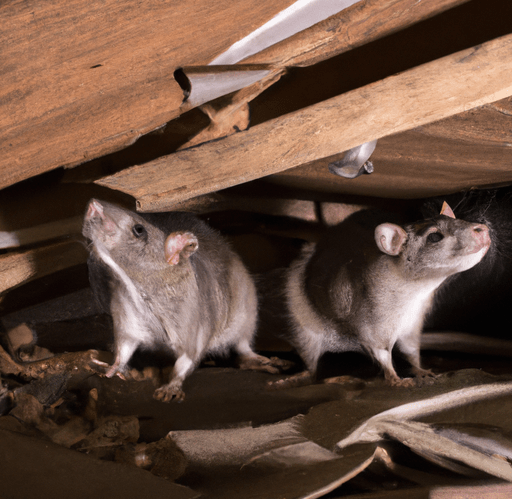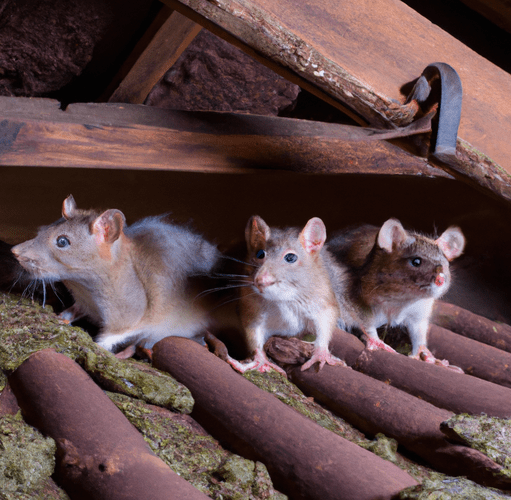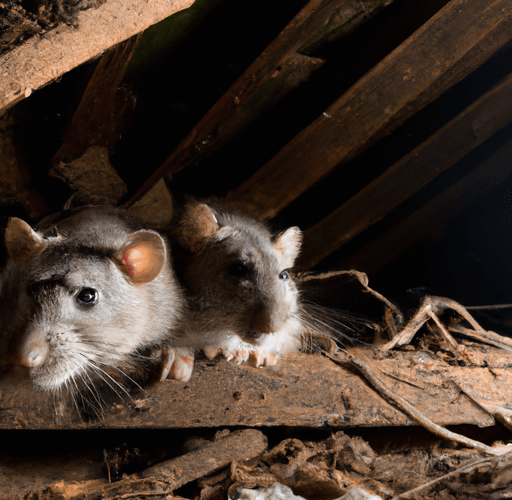Rats are some of the most harmful rodents in California because they eat and contaminate food, damage structures and property, and spread parasites and diseases. They live and thrive in various conditions and areas, including your roof.
Tired of noise in your ceiling or attic? Get sick and tired of the problems caused by those pesky roof rats already! Our top priority at Roof Doctors is ensuring that your roof and house are secure.
That’s why we will explain what roof rats in California are and how you can deal with any situation.
Identification and biology of roof rats in California
Even though rats can be difficult to spot, anyone with a reasonably good set of eyes can’t fail to notice them. Have you checked for roof rats yet? In California, two different kinds of rats are frequent invaders of roofs.

We’ll explain how to recognize them and then help you track down a long-term remedy.
1. Norway rat
Norway rats, sometimes known as brown rats or sewer rats, are primarily burrowing rodents, unlike their roof rat counterparts. They like living in low places like attics and basements but can be found just about anywhere.
Norway rats are much larger than roof rats, and a single mother can have 20 or more young per year. This is a major issue if you’re worried about rats taking over your house.
They prefer basements and bottom floors, therefore, they probably didn’t cause your rat problem upstairs.
2. Roof rats
Commonly referred to as “black rats,” roof rats are smaller than Norway rats and are likely to be the source of your roof problem.
Having longer tails for balance makes them more agile, so you might see them scurrying over power lines or fences. They prefer dwelling in higher places, coming down only to eat, and are swift and difficult to trap.
Can you tell whether you have a rat problem by looking around? Learn the signs of a rat infestation and our methods for eliminating them. You can capture some or look for them in the dark with a flashlight to determine the rat species.
How to spot rats on your roof

Keeping your roof in good condition is our top focus, so we’ll keep an eye out for any rodents that could cause problems. It’s important to monitor their activity throughout the year, so we’ll show you how to do just that.
There are a few questions you can answer; if you confirm, you may have a rat infestation.
- Do you find rat droppings, shelves, bins, or pet food containers around your pantry?
- Have you seen a rat run around your house?
- Do you ever spot rats scurrying along power wires or atop fences at night or shortly after?
- Do you ever hear noises in the attic after it gets dark?
- Is it common for your pet to bring you dead rats?
- Do you see any smears where the rats have rubbed their fur against the ceiling, the pipes, or the walls?
Keep an eye out for food that a rat may have snatched up and taken away for later feeding. Remember that roof rats on your roof and Norway rats in your basement may cause a double rat infestation.
Why are roof rats a huge concern?
We at Roof Doctors value your health and safety, and the roof that protects you is a top priority. Having roof rats can be dangerous to your property and family.
Roof rats are most active at night, compensating for their poor eyesight with their keen senses of hearing, smell, touch, and taste. Roof rats have pronounced neophobia, meaning they are likely not to try new foods other than those they are used to.
Whatever they have been eating, I can guarantee that nothing on your menu will entice them as much as that. They constantly seek new information and swiftly learn about their surroundings, including barriers and paths.
This means that for several days after being placed, they will likely avoid traps and adapt to changes you make to your surroundings, such as barriers. Roof rats can enter buildings through the plumbing system by nibbling or jumping or swimming up the drains.
Roof rats are notorious for tearing insulation out of walls and ceilings in order to build nests. They also gnaw on electrical wiring and wooden objects, including doors, ledges, corners, and wall material.
Their nest-building and chewing activity can inflict extensive harm. In California, ground squirrels, chipmunks, and native woodrats are blamed for spreading the plague, although they can also carry salmonellosis (food poisoning).
Is there any way to prevent this from happening? The following are some of the steps you can take, as recommended by Rood Doctor, to make your home rat-free.
How to get rid of roof rats in California
When it comes to getting rid of roof rats, Roof Doctor suggests three approaches: sanitation, damage control, and rodent proofing. This will eliminate the rats and their damage to your roof and prevent any more from entering your home.
1. Sanitation
Our first piece of advice is to eliminate the sources of roof rat attraction.
To keep rats out of your home and out of your way, you must practice constant sanitation.
Roof rats can be driven away by maintaining clean indoor and outdoor environments. Garbage and garden waste should be collected regularly, and containers should be covered securely when not in use.
Store pet food in rodent-proof containers and only feed your pet what it can eat at once. If they have access to dog food, rats can be a nuisance in dog-feeding areas.
2. Population control
Now that you’ve eliminated the rats’ food source, Roof Doctor recommends focusing on reducing the rats’ population and the damage they’ve caused. Depending on the population and the early phases of the infestation, many approaches might be used to exterminate the roof rats.
When rats have easy access to food, water, and a safe place to live, their numbers can grow rapidly. Direct population control is sometimes needed to limit resources like food, water, shelter, and access to structures.
It is possible to get rid of the rats by using one of the following methods:
Trapping

Rat traps are the most effective tool for eliminating pests inside a building since they can be used over and over. Rodents can perish in hard-to-reach places, like walls and ceilings, when rodenticides (toxic baits) are employed within buildings.
In attics where rats have been an issue, traps can be left indefinitely but keep in mind that young rats can’t be trapped until they leave the nest for food at a month old. You can glue or string the bait to the trap’s trigger to catch the rodent when it eats.
You should make traps with sensitive triggers to prevent trap shyness if they fail to catch the rat the first time. We advise you to leave traps baited but unset for a while to have the rats get used to the traps as a source of food.
After the rats start taking the bait, use as many set traps as possible to reduce trapping time and double the number of baited traps exposed if all bait is taken. Heavy infestations may require a dozen or more traps spaced 10-20 feet between each rat trap.
Where to place traps
To catch Norway rats, set traps along walls, behind furniture, in dark corners, and in anyplace rat droppings have been found. Place traps at right angles to a wall with the trigger end almost touching it.
Roof rat traps should be placed high up, near points where rats are likely to travel from their nests in search of food, and secured with screws or wire. Indoors, traps can be set up in the attic or garage rafters close to the source of the infestation.
To prevent children, dogs, and birds from touching traps, box or barricade them. Avoid contact with rodents at all costs, wash your hands completely after handling traps, wear disposable gloves when dealing with dead rodents, and either bury or seal up rat carcasses before throwing them away.
Glue boards
Glue boards are thin boards with an adhesive surface, and they can be used to catch rats. They work great if positioned in the attic and along potential roof rat travel routes.
If you have pets, these traps may catch other animals like lizards and birds when used outdoors. Glue boards may not kill roof rats. Therefore, you may need to kill them yourself.
A rat caught in a glue trap may struggle for several minutes, occasionally dragging the trap after it. This will need you to relocate the trap from its original location.
Placement of Bait stations and Lure Devices
During the initial stages of an infestation, roof rats can be trapped using bait stations. Rodenticide baits must be used correctly per package directions.
Do not assume that the rats will actively seek out the bait. Due to their natural wariness of new or unusual stimuli, it may take several days for rats to access and feed in bait stations.
Bait stations improve the bait’s security and make the rats feel more at ease while eating. The best places to set traps for roof rats are high up on walls or along paths they use.
It’s important to be sure that any bait stations you set up in high places aren’t going to fall to the floor and into the hands of curious children or pets. Rats will not eat stale bait; therefore, it’s important to check bait stations frequently and replace the bait if it goes bad.
Put out bait boxes near walls with nearby openings or anywhere you see rat droppings or other signs of rat activity. After a control program, all remaining bait must be removed and disposed of properly.
Rodenticides (Toxic Baits)
Toxic baits may be necessary if there are many roof rats in your home and there is a persistent re-infestation. Properly applying rodenticides requires special training and expertise; you may want to hire a professional specializing in pet control.
These rodenticide baits combine a food-like attractant with the lethal poison used against the rodents. Alternatively, anticoagulant rodenticides can be used to kill roof rats by preventing their blood from clotting.
Very low doses of the active chemicals are used, and the onset of symptoms is postponed by several days; this prevents the rat from rejecting the bait out of fear of getting sick. Because not all rats will eat the bait right away, the packaging instructions for most baits advise keeping the bait out for at least 10 or 15 days or until there is no longer any sign of rodent activity.
A two- to six-day mode of action in rodenticides prevents unintentional poisoning in the case of pet intake.
How to handle roof rats around your pets

Many baits and poisons used to kill rats are also toxic to other animals. Fast-acting second-generation anticoagulants, for instance, can lead to primary poisoning if your pet eats the bait.
If your pet eats a rat that the anticoagulant has already killed, it could be poisoned due to secondary poisoning. Be aware that all rodent baits are poisonous to dogs and cats.
All of the currently approved first-generation anticoagulants have a cumulative effect and a gradual onset of action that varies with the number of feedings. It follows that dead rats may harbor several deadly dosages of harmful substances.
Extra care must be taken when using these baits because even a small amount of exposure to a dead rat could be fatal to a pet.
The safest measure is to keep pets away from mouse bait and any rodents that may be dead or dying. All bait stations should be clearly labeled with warning information, and any unused bait should be kept locked away, out of the reach of children and pets.
Stations need to be locked or immobilized if the bait can be shaken loose when the station is lifted or overturned. Dead rodents should be disposed of by either burying them or placing them in a plastic bag and throwing them away.
3. Rodent-proofing your home
The final stage of getting rid of roof rats is ensuring that they do not infest your home again. The foundation of a structure should be sealed, as should any access points for utilities such as water, electricity, sewage, and ventilation.
To prevent damage from chewing, check the fit of all doors, windows, and screens and consider covering the edges with metal.
Roof rats may climb higher than other rodents; thus, it may take longer to identify all the possible access sites while trying to rodent-proof your home against them. Talk to a pest management expert or the utility company in your area for help figuring out how to stop roof rats from using utility lines as a highway.
If you want to get rid of roof rats, the first thing the Roof Doctor recommends doing is taking preventative measures. Here are some possible ways to accomplish this:
- Pipes, cables, and wires that enter a building through the walls or the basement should have all access points sealed.
- Fix or replace the broken ventilation screen under the eaves and all the way around the base of the building.
- Seal all openings around pipes, cables, and wires that enter through walls or the foundation.
- Verify the integrity and screen-ability of all operable windows by ensuring they are all fitted with functional screens.
- Screens located within the roof and attic vents should be intact and functioning properly.
- Any plumbing vent pipes on the roof larger than 2 inches in diameter should be screened.
- Verify that the bottoms of all outside doors are properly sealed and able to keep the elements out.


